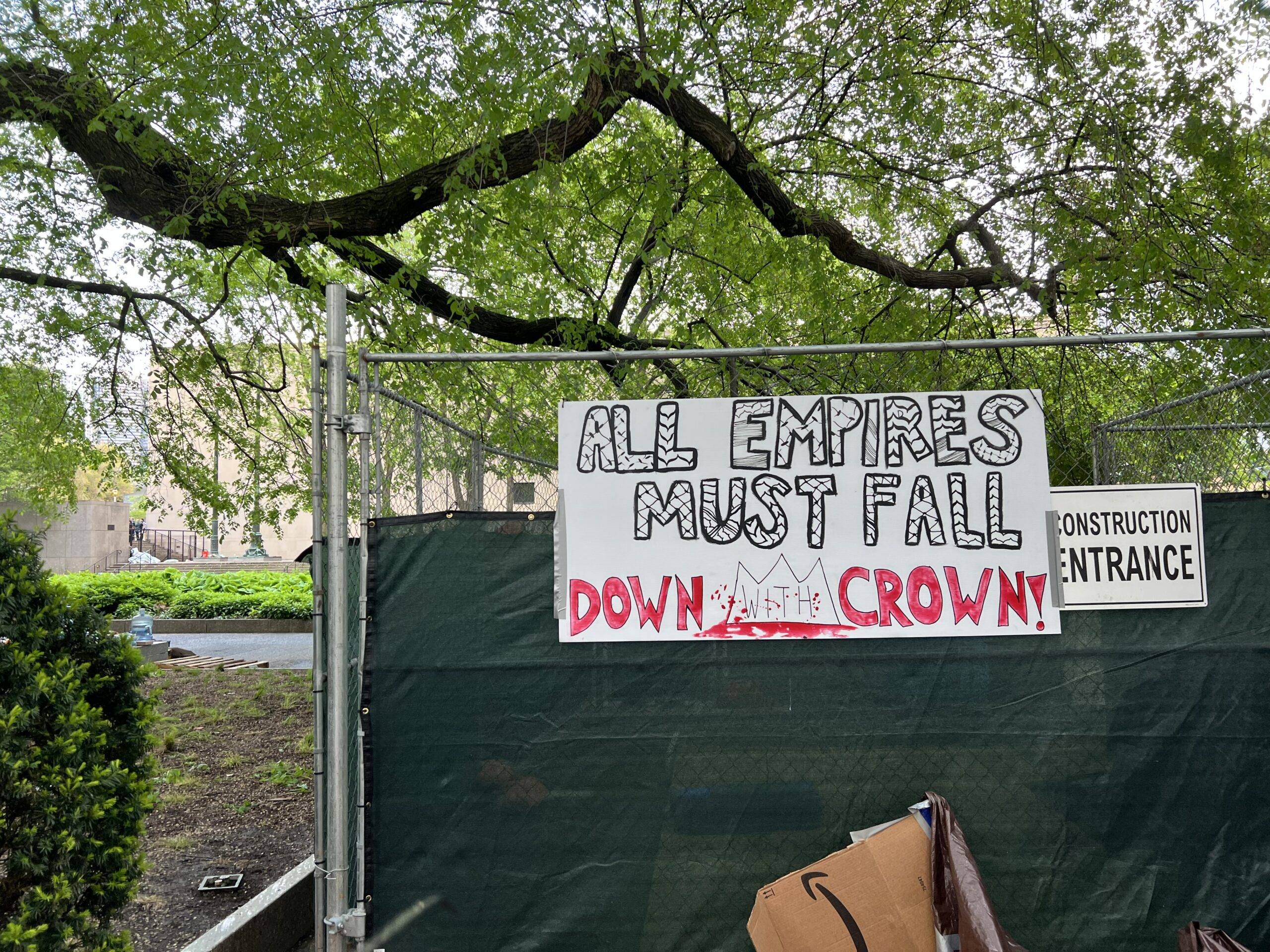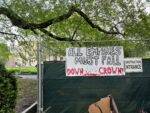By Ania Szremski, Arts Editor
Illustrations by Emily Haasch
This article is part of a series on arts writing in Chicago. Click here to read the preceding article, Getting Paid: Chicago Art Critics Talk Money.
How do New York-based online arts publications make money, and why can’t we do that here?
Borders has gone bankrupt, and Barnes and Noble is for sale. The term “crisis in art criticism” has been bandied about ad nauseum, but according to a February 26 article in the Chicago Tribune, the publishing industry as a whole now faces a “valley of death” — which has got to be a lot worse. If that’s the case, how can the market possibly support arts publishing, with its tiny, elite target demographic?
Arts publications continue to proliferate in number, but they’re hardly making money. In the December issue of F Newsmagazine, we published an article called “Getting Paid,” which featured local arts writers talking about which arts publications pay the best, and which pay the worst. The article revealed (perhaps unsurprisingly) that here in Chicago, most vehicles for arts criticism either hardly pay, or don’t pay at all. The economy being what it is, ad revenues leave something to be desired — translating into less money available for the workers who produce the content.
However, one interviewed writer, Pedro Velez, suggested that comparatively lucrative examples of online arts publications abound in New York. This month, F Newsmagazine sought out some of those online publishing endeavors to discover which models were the most innovative, the most economically viable, and which (if any) could potentially be reproduced here in Chicago.
The Multi-Pronged, Hybrid Approach
Internet pioneer Artnet was one of the first entities to fully exploit the possibilities of making money online with arts-related content. Its lucrative, hybrid model has inspired similar sites like ArtSlant and ArtInfo, and has influenced more intellectually-minded online arts publications, as well.
Artnet began as an auction database and rapidly expanded to include an events calendar, online galleries, market information services, and a boutique magazine that enlists writers internationally to report on regional art scenes.
Launching a platform for arts writing wasn’t the company’s initial goal. Editor Walter Robinson told F Newsmagazine that Artnet started “in the early ’90s as a computer database with access via a telephone modem funded by investors, mostly old master dealers like Hervé Aaron. Then in 1996, the owner, a German art dealer named Hans Neuendorf, rolled it over onto the web and launched both the gallery section and the magazine.”
Robinson told F that initially the site made money by selling users permission to search the auction database, which costs about 30 dollars a month for eight searches. The site also sells profile pages to galleries. “The minimum package is $300 a month,” says Robinson, “but many bigger galleries buy much bigger packages. Selling points include the database concept, which allows the aggregation of content in different forms; and search engine rankings, which Artnet can help with. We have a team of salespeople to convince galleries to sign on.” These revenues are what supports the online magazine component.
Artnet’s initial success inspired the company to go public on the Neuemarkt in 2000. Robinson says that after that, Artnet “raised 50 million euros, which was promptly squandered, and then the market crashed. We almost went broke a couple of times, but Hans [the owner] is hard-core and we held on. A couple of years ago we launched our own art auctions, which are a third revenue stream. … [Today, we] do about $20 million a year in revenues.”
The Artist-Run Listserv-as Project Series-as-Publication Approach
Artnet’s hybrid model of activities and revenue streams is surprisingly similar to a perhaps less financially solvent (but far more intellectual) online arts publication: that veritable behemoth of art criticism, e-flux. Since its founding in 1999 by editors Anton Vidokle and Julieta Aranda, e-flux has become one of the most influential international vehicles for arts writing (typically in the form of October-esque theory crit).
e-flux started as a for-profit listserv that eventually generated a series of more tangible projects, including an online publication. Vidokle told Hans Ulrich Obrist the story of how the enterprise was launched: “In November 1998, together with Regine Basha and Christoph Gerozissis, we organized a one night exhibition called The Best Surprise is No Surprise. … We were all really broke at the time and had only enough money to rent a room for a night, and absolutely nothing to pay for invitations or even mail press releases. At the time, I had just opened my first e-mail account and thought that maybe we should try to e-mail some press releases to our friends.
“A few days later I thought that this is something that could be structured into a service that galleries and museums could use, and a month or two later, together with another group of artist friends, Adriana Arenas, Josh Welber, and Terence Gower, we formed a company called e-flux.”
With his hallmark anti-institutional attitude, Vidokle claimed that the enterprise wasn’t financially motivated, but “surprisingly it turned profitable, and this enables it to stay fully independent of normal power structures that are just killing everything these days: the market, government funding organizations, collectors and sponsors.”
As the listserv component grew increasingly successful, e-flux launched several other projects, including a video rental project in 2004; curating the Martha Rosler Library, which is available for consultation at e-flux’s storefront location in New York; pedagogical endeavors like “Unitednationsplaza” at its second location in Berlin; and of course, in 2008 e-flux launched its now widely read online journal, which is also available in print via an on-demand publishing service.
The Scrappy Independent Blogger Approach
She may not generate 20 million a year, but Paddy Johnson has managed to establish a big name for herself with the widely read blog, Art Fag City. What makes Johnson’s site unique isn’t the fact that it’s a blog for art criticism; the difference is the way her site has been monetized, and Johnson’s sheer pluck in attempting to raise funds to support her blog and its related projects.
“I started Art Fag City in 2005,” Johnson told F Newsmagazine, “and I started it in the same way that a lot of blogs at that time were formed. Usually people were not doing very well in their jobs or were bored; in my case, I was unemployed. I was working at a number of galleries and I kept getting fired from them, so I founded the blog.”
Johnson told F that she got started by aggressively marketing the blog by sending emails to every artist she reviewed, and every gallery she visited. “That was the main way I got the word out there,” she said. “Blogs, and I think this is true of other publications, don’t really work unless they have a relationship with the real world, so that’s what I’ve tried to do.”
Johnson joined ad networks in 2006 and 2007, but the writer got her biggest financial break yet with a $30,000 Creative Capital award in 2009. “Up until that moment, I was making very little,” Johnson said, “and half of the grant just went to credit cards and taxes I owed. It also paid for a lot of travel. I went to Frieze, I went to the Venice Biennale, I was able to travel all over the country and look at a lot of art, and that was very important to my growth as a critic and writer.”
The next step for Art Fag City was launching more aggressive fundraising campaigns. “Starting three years ago I started to do fundraising. I did it because I couldn’t pay my rent. I used twitter to promote [specific projects], the blog, tumblr — all the social media tools that I had at my disposal to raise money. And I think this is something less glamorous, but definitely a major part of my campaign was that I e-mailed people individually and asked them for money.
“Today, I do fundraisers, I have advertising, and I also do speaking engagements. The way I see growing the blog is through projects, and I’ve started to curate shows. We’ll do more of those types of things that involve working with the community, because I think that is very interesting.”

Could we do that in Chicago?
Could Chicago writers and publishers learn a lesson from their New York counterparts?
Unfortunately, it may be less a question of “learning a lesson,” than a question of whether or not Chicago’s much smaller arts economy can actually support larger endeavors with a more ambitious scope. According to Paddy Johnson, she couldn’t have launched ArtFagCity anywhere other than New York.
“People here care about the art community,” she told F. “If I were anywhere else, the community would be smaller; as it is now the community I have is just barely large enough to support what I do.”
Steve Ruiz, author of the Chicago Art Review, expressed a similar sentient. According to Ruiz, his site doesn’t make any money aside from “ridiculously low” revenues from AdSense.
“I’ve experimented with advertising models, and each has failed in its own way,” he told F. “There’s a conventional blogging money model, which runs on high readership and strong advertising connections for image spots and sponsored posts. There are two reasons why I don’t use that model.
“One, there isn’t enough to talk about in Chicago’s art scene. New York has enough of a signal that it can handle the noise — Chicago doesn’t. Chicago Art Magazine is a great example of an attempt to use the conventional blog model in Chicago, and it has to be ridiculously irrelevant in order to keep up with the lack of legitimate news.”
The second reason Ruiz doesn’t go for that model is his concern for high-quality, thoughtful content, as opposed to writing chatty blog posts that might draw more readers. “Art reviews are a strange thing to market,” he said, “because they are much more valuable to those closest to the article (like the artist) than they are to the general reader. I think a model for capturing that value would scale to Chicago much more gracefully. I guess I’m saying I could (and would) never do Art Fag City in Chicago.”
We do have at least one big hometown success: Bad At Sports, founded in 2005 by artists Duncan MacKenzie and Richard Holland. This podcast/blog has grown in popularity and readership by leaps and bounds over the past six years, and, according to MacKenzie, has amassed an archive of conversations with artists and curators rivaled only by MoMA.
BAS may have excellent content, high readership and a great reputation, but it still struggles on the business end. The site survives on ad revenues brought in from the Culture Pundits networks and the occasional t-shirt sale or donation from listeners. “It doesn’t cost us anything to make the show anymore,” MacKenzie told F, “but no one makes money. We are one hundred percent volunteer run and sustained. We just sort of galvanized around the idea that we were an artist collective that makes something that looks like art journalism … and that we’d continue to do it until it stopped being fun.
When asked if he had any ideas about how Chicago-based publications could earn more revenue, MacKenzie answered, “Chicago’s art economy is undboutedly too small to support any large-scale endeavors. Well I’m not actually sure if I believe that’s true, but what is clear is that no one’s been able to galvanize the will. I think that if Chicago wanted those things, it could support those things.
“In Chicago pretty much all our writing is volunteer at this point,” MacKenzie continued. “The further we go down that road as a culture that people get more used to not paying for content, people aren’t going to value it, so you have to find a way to produce something that people value … and how to do that? We’re not entirely sure.”
























[…] and sell more advertising than I have before.This all came up when I spoke to Ania Szremski at Fmagazine this month, a writer who wants to know what publishing models could be reproduced in Chicago. I […]
Hey Chicago Art Magazine should have been discussed more with their “sponsored reviews”. That is a funny story waiting to be explored.
Oops her mercenary ways were describe in part one. My mistake.
[…] Except for Kleinman, the panelists were hesitant to discuss the ethical implications of free labor and making a living as a writer, or not. Publications should pay writers, those that do not should justify their decision, and writers must avoid exploitative situations—statements like these, which are more common sense than radical, went largely unheard. It took the boldness of a student publication, F Newsmagazine, produced by the School of the Art Institute of Chicago, to address such topics: see “Getting Paid: Chicago Art Critics Talk Money” and “Getting Paid, Part II: How They Do It in New York.” […]
[…] recently addressed the issue frankly: see “Getting Paid: Chicago Art Critics Talk Money” and “Getting Paid, Part II: How They Do It in New York.” Though the information in two other publications, The Visual Arts Critic: A Survey of Visual […]